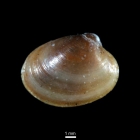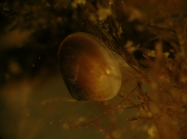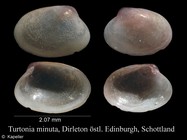CaRMS taxon details
Turtonia minuta (O. Fabricius, 1780)
141875 (urn:lsid:marinespecies.org:taxname:141875)
accepted
Species
marine
(of ) Fabricius, O. (1780). Fauna Groenlandica, systematice sistens animalia groenlandiae occidentalis hactenus indagata, quoad nomen specificium, triviale, vernaculumque, synonyma auctorum plurimum, descriptionem, locum, victum, generationem, mores, usum capturamque singuli, pro ut detegendi occasio fuit, maximaque parte secundum proprias observationes. [Fauna Greenland, systematically presenting the animals of Western Greenland so far investigated, as to the specific name, trivial, vernacular, synonyms of the authors for the most part, description, place, life, generation, manners, use and catch of each one, as there was an opportunity to discover, and for the most part according to personal observations.]. <em>Hafniae [= Copenhagen] & Lipsiae [= Leipzig], Ioannis Gottlob Rothe.</em> xvi + 452 pp., 1 pl., available online at https://www.biodiversitylibrary.org/page/13442285
page(s): 412-413 [details]
page(s): 412-413 [details]
Distribution Arctic Seas to Massachusetts; Alaska to Baja California; Europe
Distribution Often very common, circumpolar
Taxonomy Due to neoteny, Ockelmann (1964) suggested that Turtonia minuta could have been arisen out of the Veneridae.
Distribution Arctic Seas to Massachusetts; Alaska to Baja California; Europe [details]
Distribution Often very common, circumpolar
Distribution Often very common, circumpolar [details]
Taxonomy Due to neoteny, Ockelmann (1964) suggested that Turtonia minuta could have been arisen out of the Veneridae.
Taxonomy Due to neoteny, Ockelmann (1964) suggested that Turtonia minuta could have been arisen out of the Veneridae. [details]
MolluscaBase eds. (2025). MolluscaBase. Turtonia minuta (O. Fabricius, 1780). Accessed through: Nozères, C., Kennedy, M.K. (Eds.) (2025) Canadian Register of Marine Species at: https://www.marinespecies.org/CaRMS/aphia.php?p=taxdetails&id=141875 on 2025-05-08
Nozères, C., Kennedy, M.K. (Eds.) (2025). Canadian Register of Marine Species. Turtonia minuta (O. Fabricius, 1780). Accessed at: https://www.marinespecies.org/CaRMS/aphia.php?p=taxdetails&id=141875 on 2025-05-08
Date
action
by
original description
(of ) Fabricius, O. (1780). Fauna Groenlandica, systematice sistens animalia groenlandiae occidentalis hactenus indagata, quoad nomen specificium, triviale, vernaculumque, synonyma auctorum plurimum, descriptionem, locum, victum, generationem, mores, usum capturamque singuli, pro ut detegendi occasio fuit, maximaque parte secundum proprias observationes. [Fauna Greenland, systematically presenting the animals of Western Greenland so far investigated, as to the specific name, trivial, vernacular, synonyms of the authors for the most part, description, place, life, generation, manners, use and catch of each one, as there was an opportunity to discover, and for the most part according to personal observations.]. <em>Hafniae [= Copenhagen] & Lipsiae [= Leipzig], Ioannis Gottlob Rothe.</em> xvi + 452 pp., 1 pl., available online at https://www.biodiversitylibrary.org/page/13442285
page(s): 412-413 [details]
basis of record Gofas, S.; Le Renard, J.; Bouchet, P. (2001). Mollusca. in: Costello, M.J. et al. (eds), European Register of Marine Species: a check-list of the marine species in Europe and a bibliography of guides to their identification. <em>Patrimoines Naturels.</em> 50: 180-213., available online at http://www.vliz.be/imisdocs/publications/ocrd/254404.pdf [details]
additional source Gosner, K. L. (1971). Guide to identification of marine and estuarine invertebrates: Cape Hatteras to the Bay of Fundy. <em>John Wiley & Sons, Inc., London.</em> 693 pp. [pdf copepod and branchiuran :445-455]. (look up in IMIS) [details] Available for editors
additional source Ockelmann, K. W. (1964). <i>Turtonia minuta</i> (Fabricius), a neotenous Veneracean Bivalve. <em>Ophelia.</em> 1(1): 121-146. [details] Available for editors
additional source Huber, M. (2010). <i>Compendium of bivalves. A full-color guide to 3,300 of the world's marine bivalves. A status on Bivalvia after 250 years of research</i>. Hackenheim: ConchBooks. 901 pp., 1 CD-ROM. (look up in IMIS) [details]
page(s): 412-413 [details]
basis of record Gofas, S.; Le Renard, J.; Bouchet, P. (2001). Mollusca. in: Costello, M.J. et al. (eds), European Register of Marine Species: a check-list of the marine species in Europe and a bibliography of guides to their identification. <em>Patrimoines Naturels.</em> 50: 180-213., available online at http://www.vliz.be/imisdocs/publications/ocrd/254404.pdf [details]
additional source Gosner, K. L. (1971). Guide to identification of marine and estuarine invertebrates: Cape Hatteras to the Bay of Fundy. <em>John Wiley & Sons, Inc., London.</em> 693 pp. [pdf copepod and branchiuran :445-455]. (look up in IMIS) [details] Available for editors
additional source Ockelmann, K. W. (1964). <i>Turtonia minuta</i> (Fabricius), a neotenous Veneracean Bivalve. <em>Ophelia.</em> 1(1): 121-146. [details] Available for editors
additional source Huber, M. (2010). <i>Compendium of bivalves. A full-color guide to 3,300 of the world's marine bivalves. A status on Bivalvia after 250 years of research</i>. Hackenheim: ConchBooks. 901 pp., 1 CD-ROM. (look up in IMIS) [details]
 Present
Present  Inaccurate
Inaccurate  Introduced: alien
Introduced: alien  Containing type locality
Containing type locality
Unreviewed
Dimensions reaches 2 to 3 mm in size [details]Distribution Arctic Seas to Massachusetts; Alaska to Baja California; Europe [details]
Distribution Often very common, circumpolar [details]
Reproduction separate sexes, usually not dimorphic in shell structure; fertilization occurs within the mantle cavity anf young hatch as pelagic larvae (generalized for group) [details]
Taxonomy Due to neoteny, Ockelmann (1964) suggested that Turtonia minuta could have been arisen out of the Veneridae. [details]
To Barcode of Life (124 barcodes)
To Biodiversity Heritage Library (154 publications)
To Biological Information System for Marine Life (BISMaL)
To European Nucleotide Archive, ENA (Turtonia minuta)
To GenBank (125 nucleotides; 121 proteins)
To Malacopics (Turtonia minuta (O. Fabricius, 178) Norway, Nordland, Lofoten Islands, Vikten (near...
To Malacopics (Turtonia minuta (O. Fabricius, 178))
To Marine Bivalves of the British Isles webpage at National Museum of Wales
To PESI
To USNM Invertebrate Zoology Mollusca Collection
To ITIS
To Biodiversity Heritage Library (154 publications)
To Biological Information System for Marine Life (BISMaL)
To European Nucleotide Archive, ENA (Turtonia minuta)
To GenBank (125 nucleotides; 121 proteins)
To Malacopics (Turtonia minuta (O. Fabricius, 178) Norway, Nordland, Lofoten Islands, Vikten (near...
To Malacopics (Turtonia minuta (O. Fabricius, 178))
To Marine Bivalves of the British Isles webpage at National Museum of Wales
To PESI
To USNM Invertebrate Zoology Mollusca Collection
To ITIS






.jpg)







